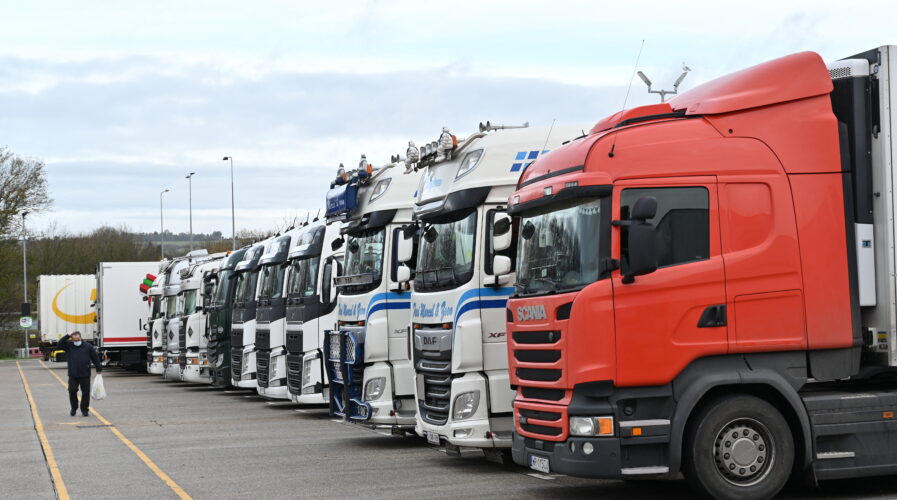
AI & IoT a game-changer for fleet management. Here’s why. (Photo by JUSTIN TALLIS / AFP)
The AI/IoT convergence is a game-changer for fleet management
- AI and IoT are disrupting fleet management given the growing need to put driver safety first without compromising cost or efficiency
- AIoT is already forming the backbone of many of today’s commercial transportation systems, especially fleet safety
Artificial intelligence (AI) and the Internet of things (IoT) are gradually becoming a constant presence in many technological applications. Both drive rapid innovation in industries ranging from healthcare to manufacturing and transportation. The path carved by recent impacts in AI-development especially has made way for unprecedented growth in the fleet management industry.
Distribution fleets benefit from AI-based applications that handle anything from route recommendations to road-risk data analysis, even driver coaching. It provides the accuracy, efficiency, convenience, and ease that earlier technology failed to provide. As a result, it is becoming safer to transport goods and services. Meanwhile, IoT connects products, assets, and infrastructures and is driving new developments and innovations in most industries.
By connecting vehicles to the Internet, there would be new opportunities for business efficiency. Many companies have already connected their fleets – General Motors is one example that has over 12 million IoT-enabled cars. The rapid growth and countless benefits associated with this technology mean that the industry is expected to grow from US$19.9 billion in 2020 to US$34.0 billion by 2025, according to Markets and Markets.
The growth of the market can be attributed to the cost benefits gained, versus the Software-as-a-Service (SaaS) and cloud-based deployments of fleet management solutions. The primary factors driving the growth of the fleet management market include the increasing government regulations and the need for optimization of fleet operating expenses. The other factors supporting market growth include the decreasing hardware and software costs and the growing need for interoperable efficiency among fleet owners.
What Is AI, IoT fleet management?
Firstly, AI models are algorithmic mathematical models that are used for decision-making, including making highly accurate predictions. They are much more complex than the linear model’s fleets once used – for instance, calculating oil change dates based on mileage. They can take multiple input variables into account to calculate very specific output, very quickly. AI models get smarter and more accurate over time as they are fed more and more data.
AI-based recommendations ensure that fleet drivers, managers, and mechanics can make better decisions that improve the long-term performance of the fleet. It also serves as assistive technology, ensuring that drivers retain autonomy during each transport cycle. AI-integrated software is usually a sophisticated system made up of several devices and applications such as IoT, predictive data analysis and machine learning systems, HD cameras and sensors, communication and display systems, and WiFi.
IoT refers to a network of actuators and sensors continuously collecting data from their environment. In fleet management, IoT ensures that enough data is captured for analysis while promoting the seamless sharing of information between all stakeholders on the supply chain such as retailers and manufacturers. AIoT is specifically useful for the fleet sector since the volume of data generated by vehicles grows each day, as fleets upgrade their technology footprint and adopt the latest advanced driver-assistance systems.
How does AI, IoT benefit fleet management?
As IoT and artificial intelligence (AI) technology solutions become more prevalent, fleet-led industries are seeing numerous benefits. By connecting to the cloud, vehicles can be monitored for faults and generate proactive maintenance updates. These intelligent vehicle assessment tools help reduce the cost of unplanned maintenance and unexpected vehicle downtime. There is also in-cab coaching which provides drivers with real-time feedback, so they can improve their performance, in-line with company health and safety standards. This data is also available to fleet managers who can proactively assess driver performance and behavior to identify training needs, disciplinary issues, or to inform employee award schemes.
Experts also reckon that connected vehicles are improving workplace efficiency and making life easier for drivers as more companies adopt electronic logging devices. Using RFID, NFC, or Bluetooth technology also reduces vehicle loading times so drivers can spend less time stock checking and more time on the road, shortening delays and improving the customer experience.
READ MORE
- Ethical AI: The renewed importance of safeguarding data and customer privacy in Generative AI applications
- How Japan balances AI-driven opportunities with cybersecurity needs
- Deploying SASE: Benchmarking your approach
- Insurance everywhere all at once: the digital transformation of the APAC insurance industry
- Google parent Alphabet eyes HubSpot: A potential acquisition shaping the future of CRM
